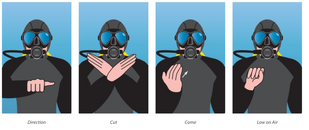I've had three occasions to share air with other divers.
The first time: was off Anacapa island in the channel islands off of California. At a depth of 20 meter(60 feet) a diver emerged ( viz about 15 feet) spun, faced me and made the OOA sign. I offered her my primary, grabbed her BC strap and we we began a controlled assent. I have used a second reg, bungeed around my neck for decades. I can simply lower my head and pick it up in my mouth.
At 15 feet, I wanted to stop and deco. She broke off and shot to the surface. Later, on the boat she said that she got lost and a combo of the cold water(temp 52 degrees) disorientation, low viz scared her and her rate of breathing accelerated. She said she was just to frightened too finish the deco stop.
Second time: I was diving in the Bahamas and I noticed diver below me( I was at 100 feet) on the wall struggling. Her inflator hose had become disconnected at the shoulder on her BC. She kept inflating and sinking. When I got to her we were at 140. I dropped in front of her, and offered my primary. I was using a five foot hose. She took it. I dropped her weight belt and we began to ascend. We had to swim about 100 yards to the anchor line. Ascending, my challenge was to add and dump air to retain neutral buoyancy for both. Once at the line she was able to pull her self up. We were still tethered. My tank pressure gauge was in the red. There was a deco bottle hanging at 10 feet and she switch off to it.
My buddy who had stuck with me but prudently remained about 10 feet from us, assessed the situation, ascended and notified the boat crew to drop another deco tank which they did. All was well that ended well. The diver had no idea that here inflator hose had become disconnected. The cable that runs through the hose was still connected to the pin but the seal on the BC was broken. She kept adding air but in vain. It just created a bubble blast that she never saw. Those bubbles are what caught my attention. I was grateful for my buddy. I have no idea where hers was or if even if she had one.
Third time:
I was diving in the Indian Ocean off of the island of Zanzibar. There were five of us in a "group dive" accompanied/led by a DM. We were about 30 minutes into a planned 45 minute dive at about 10 meters when the diver to my right and a little ahead of me went from a prone position to an almost up right and began struggling. I swam in his direction.
He had that panic look and his eyes seemed to fill his mask. I offered him my primary( 40 inch hose. I always bring my own reg and mask when ever I travel and my travel rig has a 40 inch primary). He took it and we agreed to make an ascent. The DM swam back, assessed and hovered with us. The other divers followed her and we all ascended safely and waited for the boat to pick us up. The diver stated that he just used more air than he thought he would.
Sorry to have been perhaps long winded. The take aways for me were: If you dive with a buddy, be a buddy and stick with your buddy. Always, DO a predive equipment check. There is a tendency in boat diving to empty BC's before jumping in order to get down, especially in swells and currents. Finding out you BC wont inflate at depth is the wrong time to discover that.
In all three of the situations in which I was involved, a dive axiom came to mind: all dive problems solve easier on the surface than at depth. Some dive problems, that involve the additional challenges of ceilings, real or artificial require solving where you are. I have had several of those issues myself. But that is why redundancy is advocated. And my last offering is: know your SACR and note how depth, conditions, and temperature affect it. Safe diving and don't skip the deco stops.
I was sharing these events with my buddy who reminded me that he shared air with me. I was diving the Corridor off Palm beach when he came up from behind me, grabbed my reg in one hand and gave me a thumb to ascend. On the boat we discovered one of my second stage hoses had begun to unravel from the port on the first stage. I was diving a zeagle 1st and second and its LP hose orifice accommodated a slightly larger diameter LP hose fitting than most reg LP ports. I had just had this reg serviced before our trip. We we discover back on the boat was that the O ring used on the LP fitting was not the right size for the larger hose. It was too small and had be apparently just stretched over the hose end fitting. What happened at depth was that the smaller O ring contracted, allowing for the gas under pressure, thus escaping at the port of the first stage, to twist the second stage hose without resistance. It was literally unwinding itself from the first stage. My buddy saw the rate of escaping bubbles and by clamping the first and second stage with his hand and signaling to ascend saved me from a very bad day. I found a deferent LDS.





